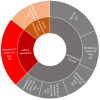Investigating Novel Genes Potentially Involved in Endometrial Adenocarcinoma using Next-Generation Sequencing and Bioinformatic Approaches
- PMID: 31692912
- PMCID: PMC6818189
- DOI: 10.7150/ijms.38219
Investigating Novel Genes Potentially Involved in Endometrial Adenocarcinoma using Next-Generation Sequencing and Bioinformatic Approaches
Abstract
Endometrial cancer is one of the most common cancers in women worldwide, affecting more than 300,000 women annually. Dysregulated gene expression, especially those mediated by microRNAs, play important role in the development and progression of cancer. This study aimed to investigate differentially expressed genes in endometrial adenocarcinoma using next generation sequencing (NGS) and bioinformatics. The gene expression profiles and microRNA profiles of endometrial adenocarcinoma (cancer part) and normal endometrial tissue (non-cancer part) were assessed with NGS. We identified 56 significantly dysregulated genes, including 47 upregulated and 9 downregulated genes, in endometrial adenocarcinoma. Most of these genes were associated with defense response, response to stimulus, and immune system process, and further pathway analysis showed that human papillomavirus infection was the most significant pathway in endometrial adenocarcinoma. In addition, these genes were also associated with decreased cell death and survival as well as increased cellular movement. The analyses using Human Protein Atlas, identified 6 genes (PEG10, CLDN1, ASS1, WNT7A, GLDC, and RSAD2) significantly associated with poorer prognosis and 3 genes (SFN, PIGR, and CDKN1A) significantly associated with better prognosis. Combining with the data of microRNA profiles using microRNA target predicting tools, two significantly dysregulated microRNA-mediated gene expression changes in endometrial adenocarcinoma were identified: downregulated hsa-miR-127-5p with upregulated CSTB and upregulated hsa-miR-218-5p with downregulated HPGD. These findings may contribute important new insights into possible novel diagnostic or therapeutic strategies for endometrial adenocarcinoma.
Keywords: CSTB; HPGD; bioinformatics; endometrial cancer; miR-127-5p; miR-218-5p; next generation sequencing; papillomavirus.
© The author(s).
Conflict of interest statement
Competing Interests: The authors have declared that no competing interest exists.
Figures






Similar articles
-
Clinical value screening, prognostic significance and key pathway identification of miR-204-5p in endometrial carcinoma: A study based on the Cancer Genome Atlas (TCGA), and bioinformatics analysis.Pathol Res Pract. 2019 May;215(5):1003-1011. doi: 10.1016/j.prp.2019.02.007. Epub 2019 Mar 7. Pathol Res Pract. 2019. PMID: 30910254
-
Hsa-microRNA-181a is a regulator of a number of cancer genes and a biomarker for endometrial carcinoma in patients: a bioinformatic and clinical study and the therapeutic implication.Drug Des Devel Ther. 2015 Feb 18;9:1103-75. doi: 10.2147/DDDT.S73551. eCollection 2015. Drug Des Devel Ther. 2015. PMID: 25733820 Free PMC article.
-
Three-microRNA signature identified by bioinformatics analysis predicts prognosis of gastric cancer patients.World J Gastroenterol. 2018 Mar 21;24(11):1206-1215. doi: 10.3748/wjg.v24.i11.1206. World J Gastroenterol. 2018. PMID: 29568201 Free PMC article.
-
Primary tumor microRNA signature predicts recurrence and survival in patients with locally advanced esophageal adenocarcinoma.Oncotarget. 2016 Dec 6;7(49):81281-81291. doi: 10.18632/oncotarget.12832. Oncotarget. 2016. PMID: 27793030 Free PMC article. Review.
-
MicroRNA Expression in Endometrial Cancer: Current Knowledge and Therapeutic Implications.Medicina (Kaunas). 2024 Mar 15;60(3):486. doi: 10.3390/medicina60030486. Medicina (Kaunas). 2024. PMID: 38541212 Free PMC article.
Cited by
-
PIK3CA mutation in endometriotic epithelial cells promotes viperin-dependent inflammatory response to insulin.Reprod Biol Endocrinol. 2023 May 11;21(1):43. doi: 10.1186/s12958-023-01094-6. Reprod Biol Endocrinol. 2023. PMID: 37170094 Free PMC article.
-
The Lifestyle Modifications and Endometrial Proteome Changes of Women With Polycystic Ovary Syndrome and Obesity.Front Endocrinol (Lausanne). 2022 Jun 22;13:888460. doi: 10.3389/fendo.2022.888460. eCollection 2022. Front Endocrinol (Lausanne). 2022. PMID: 35813634 Free PMC article. Clinical Trial.
-
Roles of PEG10 in cancer and neurodegenerative disorder (Review).Oncol Rep. 2025 May;53(5):60. doi: 10.3892/or.2025.8893. Epub 2025 Apr 4. Oncol Rep. 2025. PMID: 40183369 Free PMC article. Review.
-
Targeting IGF1R signaling enhances the sensitivity of cisplatin by inhibiting proline and arginine metabolism in oesophageal squamous cell carcinoma under hypoxia.J Exp Clin Cancer Res. 2023 Mar 28;42(1):73. doi: 10.1186/s13046-023-02623-2. J Exp Clin Cancer Res. 2023. PMID: 36978187 Free PMC article.
-
B3GNT3 acts as a carcinogenic factor in endometrial cancer via facilitating cell growth, invasion and migration through regulating RhoA/RAC1 pathway-associated markers.Genes Genomics. 2021 May;43(5):447-457. doi: 10.1007/s13258-021-01072-5. Epub 2021 Mar 8. Genes Genomics. 2021. PMID: 33683574
References
-
- World Cancer Research Fund International. Endometrial cancer statistics. 2019.
-
- Olesen TB, Svahn MF, Faber MT. et al. Prevalence of Human Papillomavirus in endometrial cancer: a systematic review and meta-analysis. Gynecol Oncol. 2014;134:206–215. - PubMed
-
- Raglan O, Kalliala I, Markozannes G, Risk factors for endometrial cancer: An umbrella review of the literature. Int J Cancer; 2018. - PubMed
-
- Banno K, Yanokura M, Iida M, Masuda K, Aoki D. Carcinogenic mechanisms of endometrial cancer: involvement of genetics and epigenetics. J Obstet Gynaecol Res. 2014;40:1957–1967. - PubMed
-
- Surveillance Epidemiology, End Results ProgramNational Cancer Institute: Cancer Stat Facts: Uterine Cancer. 2018.
MeSH terms
Substances
LinkOut - more resources
Full Text Sources
Research Materials
Miscellaneous

